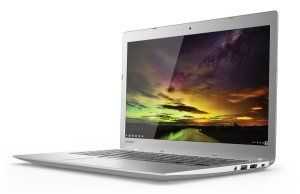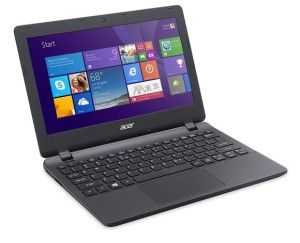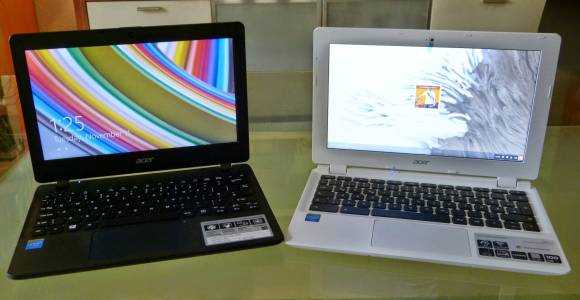After a weekend of testing the new $200 Acer E11 Windows laptop (first impressions and video here) I’ve completed my first-take on the subject of Chromebooks vs modern netbooks. Windows netbooks, or at least the new-wave of netbooks, remain the more flexible option but they don’t ‘kill’ Chromebooks. The Chromebook’s efficient, secure and manageable nature has massive appeal to the education and small-business market and Windows remains too heavyweight and too expensive / time-consuming for a ‘low-cost’ solution. It’s in the consumer space though that Windows continues to have the lead despite being an old and bulky OS. Call it the Minecraft-Skype effect or just attribute it to familiarity; Windows remains the go-to choice. The problem is that Chromebooks are getting better every day and prices are dropping quickly. Entry-level for a spritely 7-hour Chromebook is just $179. It’s great for consumers but not so good for Microsoft who need to respond quickly. Given their opportunity to improve Windows for the next version in mid 2015, what is needed to make sure that next-generation Windows stay ahead of Chromebooks for consumers? Here’s a list of issues that need to be solved, and a simple solution I’m calling a Windows Surface Laptop.
Switch-on experience.
Windows 8 is already a huge improvement over Windows 7. It boots quickly and runs efficiently. Using a Microsoft account enables account information synchronization and OneDrive storage is nicely integrated. If you use more than one Windows 8 PC it synchronizes settings and setup well across devices. File History will even restore your files if you want to reset your device but there are three issues that kill the experience. Virus checking, file indexing and updates can cause even a powerful PC to fall to its knees after turning it on. Windows 10 will still have to include these features if it retains the same OS architecture as before (it does!) but the process has to be improved. The switch-on experience with Chromebooks is fast and smooth, every time and it’s a major selling point
Disk-creep.
If Microsoft wants to support Windows 10 on a low-cost 64 GB or 32 GB drive then they need to cut disk creep. Windows updates can take a huge amount of space. Desktop applications do too and if you’re unlucky, like I was recently, OneDrive will synchronize a cache to the local disk and kill the PC within hours. A Chromebook lasts almost indefinitely on a reduced disk space without user interaction.
Disk cleanup.
Again, Windows 8 is better than Windows 7 in terms of disk monitoring and clean-up but it’s still ugly. For example, if you want to clean up Windows update files that are under 30 days old you have to use a the command-line. Windows Metro only calculates RT apps disk usage, the desktop application manager only shows desktop apps and there’s no method at all of knowing, quickly, where all the files are building up. Windows 10 needs to include monitoring, alerting, searching and clean-up tools in one place. [Note: I haven’t tested Data Sense on Windows 10 yet.] An alternative would be to store all user files off the disk and to implement a fast reset feature.
 Reset experience.
Reset experience.
PowerWash on a Chromebook is a powerful tool. Within 60 seconds you can fully reset a Chromebook into a clean and safe state. You log in and your apps, obviously cloud-based, are there within a minute. On a Windows 8 PC (with encryption turned on and assuming you don’t have to back up any files or re-install any programs) that process takes 5-10 minutes. If you don’t have disk encryption turned on and you have programs to install and data to restore it takes hours. The only way to increase this speed is to reduce the size of the Windows image, the Windows applications and to have encryption turned on by default. (It’s a security risk to simply reset file descriptors unless those files are encrypted.) Windows also needs to reset to a safe experience and not a recovery partition that might be 2 years old. Windows Store is moving to a model where apps, settings and data could be restored automatically and that’s a good start.
Secure guest mode.
Windows does have a guest mode but the account is not cleaned on logging out as it is on a Chromebook. For those worried about privacy and security the one-time login has real advantages. ChromeOS allows the use of a VPN in this mode and within the session it’s possible to log into Google Drive and work on files. Exiting guest mode removes any trace of that work. Windows needs that mode.
Sort out the memory issue.
Fact: Chromebooks can do more than Windows PCs in the same memory. Windows does some intelligent stuff in memory that can help improve performance but it still hogs memory and doesn’t gracefully use swap. When ChromeOS runs out of memory it starts to compress data in RAM to increase RAM space but Windows ends up using horribly slow disk access. Windows needs to degrade much more slowly.
Improve security.
Run Windows desktop as an administrator and you are asking for trouble. Secure boot can be turned off while personal files are still on the system. There’s little sandboxing. Resource usage is uncontrolled (e.g. network resources) and there are simply too many lines of code. Windows 8 offers improvements in the RT / Modern environment where apps are sandboxed, resource usage is kept in check and if the application adheres to some rules, it can run in the background while the PC is off. Chromebooks can’t do that (think Skype, notifications, streaming audio.) so it makes sense to push the user towards this way of working. With RT / Modern apps now floating on the desktop in Windows 10 it doesn’t look like Microsoft are going to succeed. Files must be encrypted by default.
 Add Xbox-cast.
Add Xbox-cast.
Microsoft badly needs an Xbox dongle to carry Xbox services and to extend Windows Store apps to the big screen. A Miracast adaptor isn’t good enough.
Continue with the good stuff.
Xbox music, videos, games. Skype, Minecraft, Wordament! USB support, advanced networking, free cloud storage. Data sense, Cortana, Health services. Office. Touch support.
Windows 10 is likely to improve on Windows 8.1 in every one of the above areas but it’s not going to be good enough. A new security and app model is needed. Fortunately, Microsoft already have it and it’s working well. Windows RT might have tripped-up due to lack of apps but it’s perfect as the base of a consumer laptop operating system. It’s everything we’ve discussed above except Minecraft and that, I’m sure, will be coming soon. The universal apps being built for Windows Phone will all work in Windows RT (in Windows 10) and that’s ignoring the application ecosystem for Windows Store which is a lot better than it was. Internet Explorer (RT) is one of the best touch-enabled browsers around. Office for RT is coming. The notifications center will be there in Windows and sharing between apps and the ‘net already works. Its efficient. Importantly it reduces the code base and that’s always good.
Laptops are laptops and you can’t compete on price at the very low-level but you can make a better consumer operating system and you can add some sweeteners. Free Office, free unlimited OneDrive, simple device and account management, Cortana, Lumia optics and of course, Minecraft! Games, photos and sharing are the key elements for a modern consumer laptop and Windows RT already does this better than ChromeOS.
How you market this Microsoft consumer laptop is another matter. Given that you can’t call it RT and it’s not Windows Phone 10, how do you place it? In my mind I’m already seeing the Xbox logo on the laptop but that might imply full Xbox ability. Surface Laptop? Whatever it’s called I’d pay a $350 for an 11.6-inch 64GB Core M-driven 10-hour fanless one. Would you? I’d be interested in your thoughts.
[For those that are wondering, yes, I run Chromebookworld.com too. It’s an interesting and important segment and it keeps me on my feet.]












Excellent article Chippy.
Windows10TP has given a new lease on life to old / low-spec PCs. Turning off indexing is one of the many tweaks found on Tweakhound.com that helps the cause. Bloatware is also a killer – even for a brand new laptop.
Tweaks. Are consumers interested in tweaks? I don’t think so.
I agree. MS should take note of these tweaks and make them redundant. It should not take this much work to get a new PC to go properly.
+1
Are there hosted non-cloud virtualization solutions for ChromeOS?
Disk-creep and clean up. you name the very weak spot of any ms system since its existence. dos by the way was a bad design in that respect too and ms never corrected this. the main cause for corruption of disk / system speed and ram usage of any windows system. for the average user an unsolvable problem. and ms was unwilling so far to deliver system tools for maintenance of this behaviour.
Windows is under more threat from Android than ChromeOS – for most people, Android can already do what they need Windows for, PLUS, the Android device(S) are never out of arms length.
If Windows manages to wrangle this “Core of Digital Life” status from Android, there is no need to be concerned about ChromeOS. (Put it another way, Windows could still get sidelined by Android even if it killed ChromeOS.)
But the “Core of Digital Life” bit mentioned above requires the hardware to be really small and power-efficient so as to stay with its owner throughout the day, while keeping the ability to scale-up in power to handle apps like Office, Video processing, CAD and gaming when required. It also need to take center stage for all things digital its owner will come across in daily life.
By that line of logic, the Windows device needs to be:
– Highly reliable, at least highly reset-able
– Take over Telephone & Data traffic duties
– smartphone-sized or smaller, perhaps even “headless” – without screen
– but would readily connect to screens nearby (eg. Smartwatch/Smartphones/tablets/Monitors/Projectors)
– Connect to other gadgets users may wear or come across: Sensors, Smartwatches, NFC tags, Bluetooth Headset/Mic(s), Camera(s), generally Input/Output devices (Keyboard/Mouse, Speakers, Printers)
In essence, the Windows device will need to be like a “Friendly Ghost” that follows you around, and help you with your life as much as technology allows.
Comparative advantages Windows could use to win over Android:
– Consolidate presence at “Home”: PUT A FOOT IN THE DOOR, ACT WHILE MOST PEOPLE STILL HAVE A WINDOWS PC AT HOME! Alliance with Home-automation groups and make Windows the most powerful Home-automation/Monitoring platform. Leverage Kinect and XBox. Android is just starting in this respect with set-top Boxes and has little synergy to Home-Automation. (so-far!)
– Processing Power: invent ways to use those Core-i CPUs to do things Android can’t, and make them relevant to mass consumers.
– (for the Home PC) Continuous suppy of electricity & stable Internet connection: The Windows PC at home can do somemthing 24×7. Android can’t.
Even Google doesn’t think Android is in the same category. Hence, they developed ChromeOS.
No Android tablet can compare to my Windows tablet. Trust me, I’ve tested iOS and Android extensively, and as far as the tablet form factor goes, I’m sold on Windows now. The browsing experience isn’t limited in any way and actually faster than any I’ve used. Access to all of my Windows applications. Networking without hassle or even setup. XBMC on a more solid OS without bugs or issues that Android has. The list goes on. If anything, ChromeOS and Android have to worry more about Windows than ever. It is up-and-coming and Intel is pushing their chips bigtime in China. Laugh at me now, like some folks did when I told them tablets were coming and e-ink would fall by the wayside to converged devices with LCD screens, but mark my words – Micrsoft may have gotten to the battle late, but this war is only beginning.
Reset experience: It would be a good start, if Windows 8 images worked for refreshing Windows 8.1. Since I considered 8.1 kind of a service pack, I was surprised when I had to reset my device and found that the glorious refresh feature did no longer work. Personally I switched to using a Linux live system and ntfsclone for that reason.